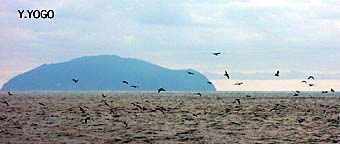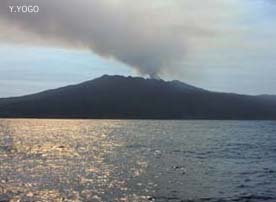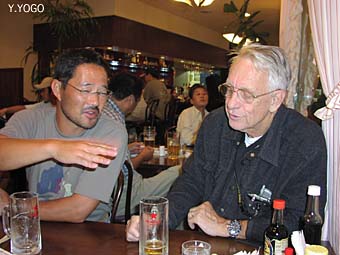1.The history
of the eruptions (October 24, 2001)
It has been more than a year since
the eruption of Oyama of Miyake-jima. Dr. Jack Moyer, an honorary
member of AUNJ, is one of the residents of Miyake-jima who had
to evacuate the island and have been living as a refugee in Tokyo
since then.
When I met Dr. Moyer the other day,
he showed me some essays about Miyake-jima which he had written
after the evacuation and most of which had appeared serially
in a magazine , "Sokotoko".
Here are some excerpts of the essays
and the conversations.
Oyama, a volcano on Miyake-jima, began
it volcanic activity for the first time in the Pleistocene epoch,
Quaternary period, and in recent years, erupted almost every
20 years, in 1940, 1962, 1983 and on July 8, 2000. After last
year's eruption a crater lake was formed on the top of the mountain,
while Hacchoudaira, a large swamp around the old crater had disappeared.
On August18, Oyama violently erupted plenty of ashes which accumlated
on the island. When it rained, moist ashes turned into avalanche
and overran the island. It was the western and north-eastern
parts of the island that were particularly damaged. In the north-eastern
part of the island the ashes, which had been spewed out by the
eruption and been carried down by a south-west wind, poured onto
the seashore. In the meanwhile, many plants on the island suffered
from as much as accumlated and clung ashes and toxic gases.
In my opinion, the volcanic activity
of Oyama of this time accompanied by plenty of ashes and gases
is different from the previous cases. As Oyama has still been
erupting gases each day, it is said that the termination of the
activity will be difficult to predict.
Before the eruption, at the beginning
of August, I dived into the sea near Shimashita, the north-eastern
part of the island, in which there is a famous diving point,
Kamanoshiri Beach . The reason why I particularly chose this
part of the sea to dive was because it seemed to be the most
damaged part by ashes. Visibility of underwater was almost zero.
It was only when I reached the bottom of the sea that I somehow
managed to see my own feet. On the seabed covered with ashes,
I found many shells of dead ear shells, Suluculus aquatilis
, however, hardly any fish. They probably had escaped to the
offshore.
A few days after the first diving I
went diving for the second time. This time visibility has been
improved a little and I could see some parrotfish, Calotomus
japonicus eat red algae, Gelidium spp. which had survived
on the top of the rocks. On the seabed covered with ashes there
were dead Gelidium and dead corals. I found plenty of
dead crabs and dead hermit crabs as well.
At the beginning of September all the
residents of Miyake-jima were officially required by Tokyo Metropolitan
Government to leave the island. In January I observed the island
from a helicopter to find both some well known plants as a local
speciality, Angerica keiskei covered with many buds and
beautiful green tea bushes. You can imagine how relieved I was! After
that inspection, I managed to watch Miyake-jima still produce
smoke from a ship whenever I visited Mikura-jima.
When Oyama erupted in 1962 and 1983,
as a resident of Miyake-jima, I witnessed the terrible incidents
and shared the struggle for reconstruction with other residesnts
of the island. Since last year's explosion, I have been hoping
the island will revive as early as possible. In the meantime,
as a naturalist, I have been keeping an eye on the condition
and recording how the volcanic activity influenced, changed,
and is changing the wildlife on the island.
2.A bird Island
(November 10, 2001)
Requested by Tokyo Metropolitan Bureau
of Environment, the Zoological Society of Japan has been undertaking
the inspection of the wildlife on Miyake-jima, particularly of
the terrestrial organisms. Cooperated by the staffs of Metropolitan
Fisheries Experiment Station, Metropolitan Bureau of Industrial
and Labor Affairs has energitically been examining how main marine
life, for example, Suluculus aquatlis and Gelidium,
the important fisheries resources, had seriously been damaged
by the volcanic activity. These inspections of bionic community
and environment of Miyake-jima, as well as observation of volacanic
activity, should be continued in future.
Although I hope the media will give informations about the situation
of Miyake-jima to as many people as possible, my concern is that
a lot of rather pessimistic news has been reported. I would like
to expect the media to inform only the facts exactly as they
are.
Although Miyake-jima is surrounded
by the ocean, it is called as " A bird Island" as well.
There are plenty of birds which live in the forest, on the tideland
and the sea, and both distribution and the life style of which
are very interesting. For example, there are Synthliboramphus
wumizusume (kanmuri-umisuzume) which first called my attention
to Miyake-jima, three protected species, Turudus celaenops
(Akakokko), a symbol of Miyake-jima, Phyllosopus ijimae
(iijimamusikui), and Columba janthina (Karasubato),
and Locustella pleskei (Uchiyamasennyu), Zosteropidae
palpebrosa (Sichitomejiro) , which is slightly different
from one of the main island, Basmbusicola thoracia (Kojyukei),
Calonectris leucomelas (Omizunagidori) breeding on Mikura-jima,
etc.

Figure 1 Calonectris leucomelas
flying in groups around
Mikura-jima at dusk (photographed on October 4, 2001,
by Y. Yogo)
Many of these birds on Miyake-jima
have been decreased in number since last year's explosion. However
pity it is, the decrease is inevitable. The most serious problem
occurred to those which had bred on Miyake-jima, represented
by Locustella pleskei. They used to live in the swamp
called Hacchoudaira around the old crater. However, as I have
already mentioned, the swamp completely had disappeared after
last year's eruption.
To my relief, after the inspection
it was confirmed that Locustella pleskei has been breeding
around Shinmyo-ike. This pond had once dried up after the eruption
in 1983, however, the bottom of the pond has gradually been changing
into a swamp. The nature has proved its amazing ability to survive
by this fact and reminded us that it always prepares the second
best measures.
Miyake-jima has a 7,000-year history.
During these years the island had been damaged by various natural
disasters, for example, eruptions of a valcano, typhoons etc.,
however, it has survived. In the meantime, wildlife on the island
have also survived, reproduced and lived its daily lives. Although
it seems the latest volcanic activity of Oyama is unpredecented,
that is only from scientific human viewpoit and human time standard.
The length of the history of evolution is far beyond human imagination
and wildlife might survive even changing individual life styles.

Figere 2 Oyama, still producing smoke(photographed
on October 3、2002, by Y. Yogo)
3.The day the
residents return to the island
(November 21, 2001)
As one of the residents of Miyake-jima
I sincerely hope all the residents will be able to go back to
the island as soon as possble. The problem is how the people
economically start their new lives. It is not all the residents
that can regain their previous economic conditions.
For the day the residents return to the island, a new system
of observation for volcanic activity and toxic gases has already
been organaized. And electiricity, gas, water, telephone etc.
have been kept in order. However, economically new lives of the
people will still be threatened by various desturctions, changes
and uncertainty.
Since the residents have reluctantly
been living as refugees, I think it is a good opportunity for
them to consider about reconstruction of the island. In my opinion,
eco-tourism will be ideal for that. Basically, eco-tourism should
be organaized by and profitable for local residents. Before last
year's eruption, many people used to visit Miyake-jima for bird
watching, fish watching and dolphin watching, because the island
is not far from large cities, easy to approach and surrounded
by abundant nature. However, there were many problems about rules
of eco-tourism. Therefore, new eco-tourism should seriously be
discussed for rebuilding of Miyake-jima.

Figure 3 Dr. Moyer and Mr. Unno discussing
about the future of Miyake-jima (photographed on October
5, 2001, by Y.Yogo)
There is another suggestion that I
would particularly like to make.
The wildlife on Miyake-jima was damaged
by the volcanic activity. Therefore, as a guide given by the
nature, some places should be preserved as sanctuaries based
on which people can study changing of the wildlife after the
eruption and continue their examination in future. Naturally
a new system should be organaized with a detailed plan. Both
the places which were damaged and not damaged should be remained.
Particularly, Shinmyo-ike area, where Styan's grasshopper warbler,
Locustella pieskei were confirmed to breed, should be
conserved as a special sanctuary.
Remarks of the
secretariat of AUNJ:
translated by Sirabe Maruta, Staff
of the secretariat
edited by Yutaka Yogo (Ph.D), Representative of AUNJ